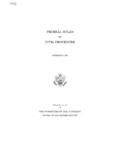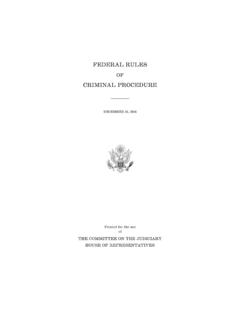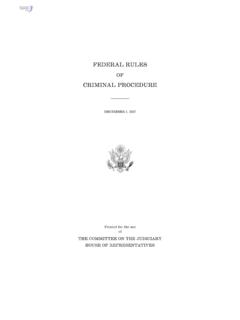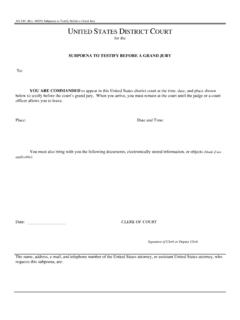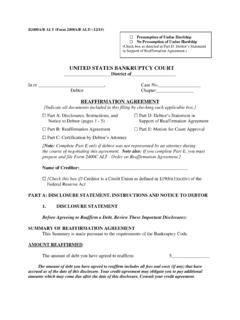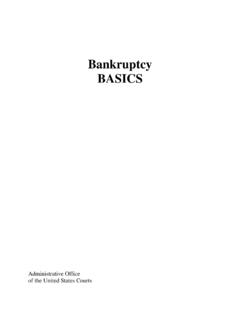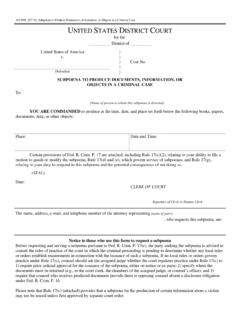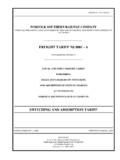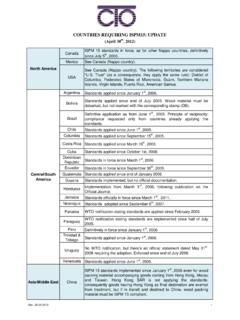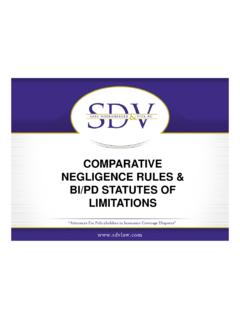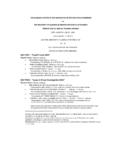Transcription of Robert Timothy Reagan, Shannon R. Wheatman, …
1 Sealed SettlementAgreements inFederal district CourtRobert Timothy Reagan, Shannon R. Wheatman, Marie Leary,Natacha Blain, Steven S. Gensler,George Cort, Dean MiletichFederal Judicial Center 2004 This Federal Judicial Center publication was undertaken in furtherance of the Center sstatutory mission to develop and conduct education programs for the judicial views expressed are those of the authors and not necessarily those of the Federal Ju-dicial page is left blank intentionally to facilitate printing of the document vThe Report 1 The Law of Sealing 1 Findings 3 Conclusion 8 Appendix A. Method A-1 Appendix B. Federal district Court rules on Sealed Records B-1 Appendix C. Descriptions of Cases with Sealed Settlement Agreements C-1 This page is left blank intentionally to facilitate printing of the document are grateful to our colleagues Pat Lombard, Angelia Levy, David Guth,Donna Pitts-Taylor, Vashty Gobinpersad, and Estelita Huidobro for their assis-tance with this project.
2 We are grateful to Ed Cooper, Rick Marcus, RussellWheeler, Jim Eaglin, Syl Sobel, Tom Willging, Molly Treadway Johnson, KenWithers, Martha Kendall, and Geoff Erwin for advice on this report. We are es-pecially grateful to the clerks of court, other court staff, and archive personnelwho provided us with information and helped us acquire access to court page is left blank intentionally to facilitate printing of the document ReportThe Judicial Conference of the United States Advisory Committee on Civil Rulesasked the Federal Judicial Center to conduct research on sealed settlementagreements filed in federal district court. Although the practice of confidentialsettlement agreements is common, the question is how often and under what cir-cumstances such agreements are filed under civil cases settle before trial, and defendants commonly seek confiden-tiality agreements concerning the terms of settlement.
3 Usually such agreementsare not filed. A high proportion of civil cases settle,1 but a sealed settlementagreement is filed in less than one-half of one percent of civil cases. In 97% ofthese cases, the complaint is not Law of Sealing It is clear that the courts of this country recognize a general right to inspect andcopy public records and documents, including judicial records and documents. Nixon v. Warner Communications Inc., 435 589, 597 (1978) (footnotes omitted). It is uncontested, however, that the right to inspect and copy judicial records isnot absolute. Every court has supervisory power over its own records and files,and access has been denied where court files might have become a vehicle forimproper purposes. Id. at is a principal reason for public access. Joy v. North, 692 , 893 (2d Cir. 1982) ( An adjudication is a formal act of government, the basisof which should, absent exceptional circumstances, be subject to public scru-tiny.)
4 ; Jessup v. Luther, 277 926, 928 (7th Cir. 2002) ( the public cannotmonitor judicial performance adequately if the records of judicial proceedingsare secret ); id. at 929 ( The public has an interest in knowing what terms of set-tlement a federal judge would approve and perhaps therefore nudge the partiesto agree to. ); Union Oil Co. of California v. Leavell, 220 562, 568 (7th Cir. 2000)( The political branches of government claim legitimacy by election, judges byreason. Any step that withdraws an element of the judicial process from publicview makes the ensuing decision look more like fiat, which requires compellingjustification. ).Courts of appeals have determined that the common law presumption of ac-cess applies to documents filed with the court, although it does not apply todocuments exchanged in discovery, Federal Trade Commission v.
5 Standard FinancialManagement Corp., 830 404, 408 (1st Cir. 1987); United States v. Amodeo, 1044, 1050 (2d Cir. 1995), or to settlement agreements not filed, Pansy v. Bor-ough of Stroudsburg, 23 772, 781 83 (3d Cir. 1994). Also, the presumption ofpublic access is stronger for documents filed in conjunction with substantive ac-tion by the court than for documents filed as part of discovery disputes. Anderson 1. An analysis of disposition codes for civil terminations from 1997 through 2001 showed that22% were dismissed as settled and 2% were terminated on consent judgment. Another 10% werevoluntary dismissals, and some of these probably were settled. An additional 20% are coded as other Settlement Agreements2v. Cyrovac Inc., 805 1, 11 (1st Cir. 1986); Leucadia Inc.
6 V. Applied ExtrusionTechnologies Inc., 998 157, 165 (3d Cir. 1993); Foltz v. State Farm Mutual Auto-mobile Insurance Co., 331 1122, 1135 36 (9th Cir. 2003); Chicago Tribune Co. Inc., 263 1304, 1312 (11th Cir. 2001).Some court opinions have explicit statements that if a settlement agreement isfiled with the court for the court s approval or interpretation, then denying thepublic access to the agreement requires special circumstances. Bank of AmericaNational Trust & Savings Association, 800 339, 345 (3d Cir. 1986) ( Once a set-tlement is filed in the district court, it becomes a judicial record, and subject tothe access accorded such records. ); Herrnreiter v. Chicago Housing Authority, 634, 637 (7th Cir. 2002) ( [Defendant s] desire to keep the amount of itspayment quiet (perhaps to avoid looking like an easy mark, and thus drawingmore suits) is not nearly on a par with national security and trade secret infor-mation.)
7 Now that the agreement itself has become a subject of litigation, it mustbe opened to the public just like other information (such as wages paid to an em-ployee, or the price for an architect s services) that becomes the subject of litiga-tion. ); Brown v. Advantage Engineering Inc., 960 1013, 1016 (11th Cir. 1992)( It is immaterial whether the sealing of the record is an integral part of a negoti-ated settlement between the parties, even if the settlement comes with the court sactive encouragement. Once a matter is brought before a court for resolution, it isno longer solely the parties case, but also the public s case. Absent a showing ofextraordinary circumstances .!.!.!, the court file must remain accessible to thepublic. ).Many appellate opinions have stressed the importance of the court s statingspecific reasons for sealing a filed document.
8 In re Cendant Corp., 260 183,194 (3d Cir. 2001) ( Broad allegations of harm, bereft of specific examples or ar-ticulated reasoning, are insufficient. ); Stone v. University of Maryland Medical Sys-tem Corp., 855 178, 182 (4th Cir. 1988) ( the district court must provide aclear statement, supported by specific findings, of its reasons for sealing any rec-ords or documents, as well as its reasons for rejecting measures less drastic thansealing them ); Hagestad v. Tragesser, 49 1430, 1435 (9th Cir. 1995) ( becausethe district court failed to articulate any reason in support of its sealing order,meaningful appellate review is impossible ).Only two federal district courts have local rules pertaining specifically tosealed settlement agreements. The district of South Carolina proscribes them, (C), and the Eastern district of Michigan limits how long theymay remain sealed, Mich.
9 Forty-nine districts (52%) have local rulespertaining to sealed documents generally. Fourteen districts (15%) have rulescovering only administrative mechanics ( , how sealed documents aremarked),2 thirty-two districts (34%) have rules covering how long a documentmay remain sealed (after which it is returned to the parties, destroyed, or un- 2. California Central, California Eastern, Colorado, Delaware, district of Columbia, GeorgiaSouthern, Indiana Southern, Montana, New Hampshire, New York Northern, Oklahoma Western,Rhode Island, Vermont, Wisconsin Report3sealed),3 and twelve districts (13%) have good-cause These rules are com-piled in Appendix examined 288,846 civil cases that were filed in a sample of 52 districts. Wefound 1,270 cases with sealed settlement agreements ( ).
10 That is one in ap-proximately 227 sealed settlement rate for individual districts ranges from considerablyless than the national rate to considerably more than that rate. Figure 1 showssealed settlement rates for individual districts. Three districts (6%) had no sealedsettlement agreements Indiana Northern, Iowa Southern, and South districts (6%) had sealed settlement rates more than twice the nationalrate Pennsylvania Eastern ( ), Hawaii ( ), and Puerto Rico ( ).6We studied all eleven districts whose local rules require good cause to seal adocument. The rate of sealed settlement agreements in those districts was rate of sealed settlement agreements in the other districts was somewhathigher but the difference was not statistically settlement agreements appear in cases of many different types. Table 1shows nature-of-suit frequencies. More than half of the cases with sealed settle-ment agreements are either personal injury cases (30%) or employment cases(27%).
